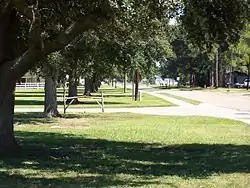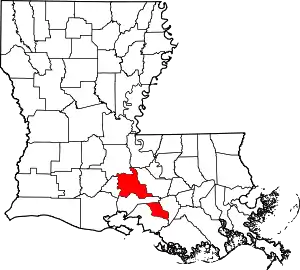Cecilia, Louisiana
Cecilia is a census-designated place (CDP) in St. Martin Parish, Louisiana, United States. The population was 1,505 at the 2000 census. In 2018, the Census Bureau estimated Cecilia's population to have grown to 1,987.[1] It is part of the Lafayette Metropolitan Statistical Area and Acadiana.
Cecilia, Louisiana | |
|---|---|
 Downtown Cecilia | |
 Cecilia, Louisiana Location of Cecilia in Louisiana | |
| Coordinates: 30°20′11″N 91°50′52″W | |
| Country | United States |
| State | Louisiana |
| Parish | St. Martin |
| Area | |
| • Total | 2.1 sq mi (5 km2) |
| • Land | 2.1 sq mi (5 km2) |
| • Water | 0.0 sq mi (0 km2) |
| Elevation | 26 ft (8 m) |
| Population (2018) | |
| • Total | 1,987 |
| • Density | 950/sq mi (370/km2) |
| Time zone | UTC-6 (CST) |
| • Summer (DST) | UTC-5 (CDT) |
| Area code(s) | 337 |
Geography
Cecilia is located at 30°20′11″N 91°50′52″W (30.336379, -91.847867).[2]
According to the United States Census Bureau, the CDP has a total area of 2.1 square miles (5.4 km2), all land.
History
Cecilia sits on land that was historically inhabited by the Atakapa Tribe. The Atakapa lived in what is now Southwest Louisiana and Texas, and had a trading post at St. Martinville, before French settlers took over the land.[3]
Cecilia was originally known by the Spanish as La Punta, describing a deep bend in Bayou Teche. This was translated by the French into La Grande Pointe, a name that was used by many people until modern times when it was then called Cecilia, named after the first postal clerk. The community began as a small service center of sorts for the many landowners in outlying areas. As more settlers populated the land along the northern Bayou Teche, the need grew for easier access to religious services, education, and trade. It was because of these basic needs that the community became more than a crossover on the bayou trail between Opelousas and St. Martinville,

Pierre Guidry, the first settler of Cecilia, acquired three tracts of land from Mrs. Joseph Alexander Declouet in 1791. Joseph Angelle settled nearby soon after.
Both men apparently settled on lands that had been given to Declouet by a Spanish land grant dated May 16, 1772, that included some 2,600 acres (11 km2) of land.
Grover Rees I, in his history of Breaux Bridge, describes Guidry's land as "fronting 50 arpents on Bayou Teche and 50 arpents deep, for which he agreed to deliver in payment 100 bulls." Guidry married three times and fathered 20 children, many of whom remained in the area and established their own farms.
There was a chapel at La Grande Pointe sometime after 1874. Some sources say that it was named for St. Etienne, but that is not a certainty. In January 1889, Father Borias of Breaux Bridge wrote that "the chapel was originally located about midway between the Four Corners and Grand Anse area, but later was moved closer to what is now Cecilia." A church parish was created at Cecilia in 1890 and Rev. Augustin Blanc became first pastor. He would serve there for more than 38 years. St. Rose of Lima Church was established there for the African American congregation in 1944.
During the Civil War, the settlement was also known as La Place. This name was dropped when postal authorities began to confuse it with the LaPlace in St. John the Baptist Parish.
There are several stories about how the place was named Cecilia, the most accepted being that it was named for Cecilia Lastrappes, the first postmistress there.
Cecilia is the birthplace of several Louisiana political figures: state Representative and House Speaker Robert Joseph "Bob" Angelle (1896–1979), former Secretary of State of Louisiana and Lieutenant Governor Paul J. Hardy (born 1942), and former state Representatives J. Burton Angelle and Jesse J. Guidry, who became secretary of the Louisiana Department of Wildlife and Fisheries; Angelle from 1972 to 1980 and 1984 to 1988 and Guidry from 1981 to 1984. Former National Football League player Ramsey Dardar was also born in Cecilia.[4]
Cecilia is the burial site of Louis Hebert, a Confederate general. On April 19, 1964, dedication ceremonies were held in a grove of live oaks on the banks of Bayou Teche about three miles (5 km) from Cecilia on Highway 328 to mark Hebert's grave. The marker reads as follows: "Approximately 100 yards (91 m) to the west is the probable resting place of General Louis Hebert, C. S. A. Born in Iberville Parish in 1820, Hebert graduated from West Point in 1845 third in his class. After an army service of two years, he resigned to manage his family's sugar interests. Before the war he was a member of the State Senate and Chief Engineer of Louisiana. He fought at Wilson's Creek, Elkhorn, Corinth, Vicksburg, and Port Fisher. He was an editor and teacher in Iberville and St. Martin parishes and lived until 1901." (General Hebert taught at Huron Plantation near Cecilia and tutored children of Vincent Barras in St. Martinville.)
Demographics

As of the census[5] of 2000, there were 1,505 people, 531 households, and 396 families residing in the CDP. The population density was 863.3 people per square mile (334.0/km2). There were 578 housing units at an average density of 331.6 per square mile (128.3/km2). The racial makeup of the CDP was 57.34% White, 41.53% African American, 0.53% Native American, 0.33% Asian, and 0.27% from two or more races. Hispanic or Latino of any race were 1.66% of the population.
There were 531 households, out of which 38.8% had children under the age of 18 living with them, 52.7% were married couples living together, 17.9% had a female householder with no husband present, and 25.4% were non-families. 21.5% of all households were made up of individuals, and 8.1% had someone living alone who was 65 years of age or older. The average household size was 2.83 and the average family size was 3.33.
In the CDP, the population was spread out, with 30.6% under the age of 18, 10.4% from 18 to 24, 29.1% from 25 to 44, 19.3% from 45 to 64, and 10.5% who were 65 years of age or older. The median age was 32 years. For every 100 females, there were 93.4 males. For every 100 females age 18 and over, there were 88.4 males.
The median income for a household in the CDP was $25,976, and the median income for a family was $29,653. Males had a median income of $36,250 versus $16,959 for females. The per capita income for the CDP was $10,931. About 27.5% of families and 31.4% of the population were below the poverty line, including 35.6% of those under age 18 and 25.5% of those age 65 or over.
Cecilia is one of the last remaining strongholds of Cajun Language in Louisiana and 42.60% of the total population uses the language for daily communication, including 20.25% of the children.[6]
Education
Public schools in St. Martin Parish are operated by the St. Martin Parish School Board. The community of Cecilia is zoned to Cecilia Primary School (Grades PK-2), Teche Elementary School (Grades 3-5), Cecilia Junior High School (Grades 6-8), and Cecilia High School (Grades 9-12).
References
- "Cecila CDP, Louisiana". United States Census Bureau. United States Census Bureau. Retrieved 15 February 2020.
- "US Gazetteer files: 2010, 2000, and 1990". United States Census Bureau. 2011-02-12. Retrieved 2011-04-23.
- "St. Martin is the Cradle of French Louisiana". Lafayette Daily Advertiser. Retrieved 15 February 2020.
- "Ramsey Dardar NFL Football Statistics". Pro-Football-Reference.com. Retrieved May 5, 2013.
- "U.S. Census website". United States Census Bureau. Retrieved 2008-01-31.
- "Archived copy". Archived from the original on 2013-08-15. Retrieved 2013-08-10.CS1 maint: archived copy as title (link)
The History of St. Martin- an Overview 1987 by Kenneth P. Delcambre. Official Report Relative to the Conduct of Federal Troops in Western Louisiana, During the Invasions of 1863 and 1864 – Compiled and Sworn Testimony Under the Direction of Gov. Henry W. Allen, Shreveport, La., April, 1865, by Kenneth P. Delcambre. First Facts about Breaux Bridge, Louisiana – March 1988 by Kenneth P. Delcambre and Claude J. Kenneson.
